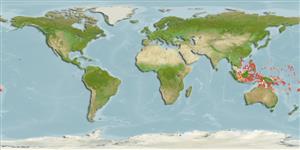>
Gobiiformes (Gobies) >
Gobiidae (Gobies) > Gobiinae
Etymology: Eviota: No etymology given, suggested by Christopher Scharpt: from Latin 'eu' for 'true' and 'iota' for anything very small, in combination 'truly very small' referring to it as being the smallest vertebrate at the time it has benn described by Jenkins (thus, making the suggestion by Scharpt plausible.
More on authors: Jewett & Lachner.
Environment: milieu / climate zone / depth range / distribution range
Écologie
marin récifal; profondeur 1 - 29 m (Ref. 86942). Tropical; 19°N - 20°S
Western Central Pacific: Fiji where there are confirmed records from numerous localities. Other records from throughout the western Pacific Ocean may represent a species complex.
Taille / Poids / Âge
Maturity: Lm ? range ? - ? cm
Max length : 2.1 cm SL mâle / non sexé; (Ref. 113727)
Description synthétique
Clés d'identification | Morphologie | Morphométrie
Épines dorsales (Total) : 7; Rayons mous dorsaux (Total) : 8 - 10; Épines anales: 1; Rayons mous anaux: 7 - 8. This species is distinguished by the following characters: cephalic sensory-canal pore system lacking only the IT pore (pattern 2); branched pectoral-fin rays; dorsal/anal-fin formula 9/8; the fifth pelvic-fin ray is 10-20% of fourth ray; absence of postocular spot; without dark spot on preural centrum area nor prominent dark spots on pectoral-fin base; caudal fin with strong scattered well-spaced dark spots (Ref. 107299).
Inhabits sheltered reefs in 1-20 m (Ref 90102). Occupies a limited range of substrates: dead reef, dead reef with silty sand, silt, and also fine sand (Ref. 116739).
Life cycle and mating behavior
Maturité | Reproduction | Frai | Œufs | Fécondité | Larves
Greenfield, D.W. and R. Winterbottom, 2016. A key to the dwarfgoby species (Teleostei: Gobiidae: Eviota) described between 1871 and 2016. J. Ocean Sci. Found. 24:35-90. (Ref. 113727)
Statut dans la liste rouge de l'IUCN (Ref. 130435: Version 2024-2)
Menace pour l'homme
Harmless
Utilisations par l'homme
Outils
Articles particuliers
Télécharger en XML
Sources Internet
Estimates based on models
Phylogenetic diversity index (Ref.
82804): PD
50 = 0.5000 [Uniqueness, from 0.5 = low to 2.0 = high].
Bayesian length-weight: a=0.00692 (0.00284 - 0.01683), b=3.10 (2.92 - 3.28), in cm total length, based on LWR estimates for this Genus-body shape (Ref.
93245).
Niveau trophique (Ref.
69278): 3.1 ±0.3 se; based on size and trophs of closest relatives
Résilience (Ref.
120179): Haut, temps minimum de doublement de population inférieur à 15 mois (Preliminary K or Fecundity.).
Fishing Vulnerability (Ref.
59153): Low vulnerability (10 of 100).
Nutrients (Ref.
124155): Calcium = 484 [196, 1,654] mg/100g; Iron = 1.82 [0.73, 4.28] mg/100g; Protein = 17.5 [15.4, 19.5] %; Omega3 = 0.108 [0.032, 0.339] g/100g; Selenium = 38.1 [9.9, 125.7] μg/100g; VitaminA = 105 [18, 570] μg/100g; Zinc = 5.02 [2.57, 8.75] mg/100g (wet weight);
